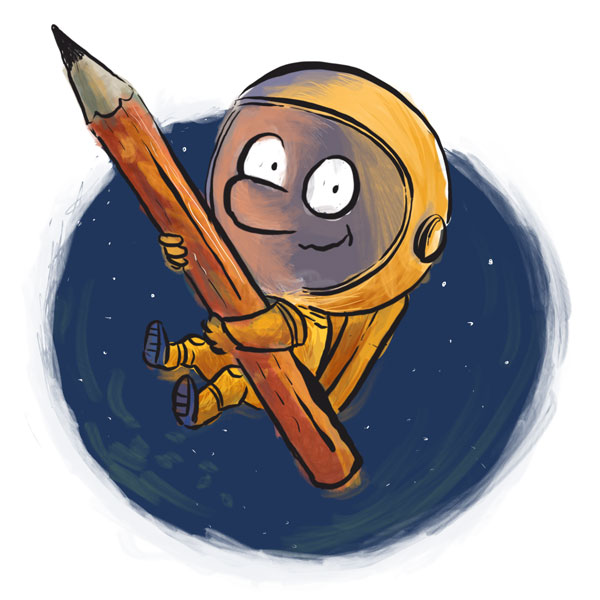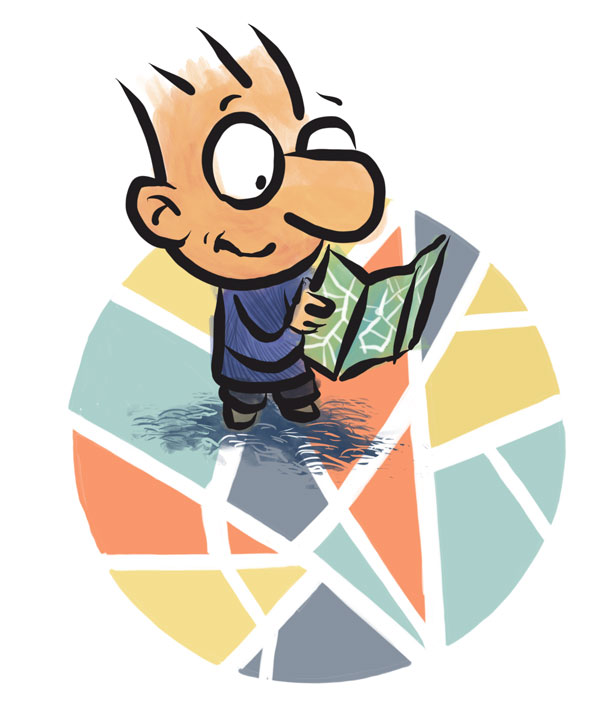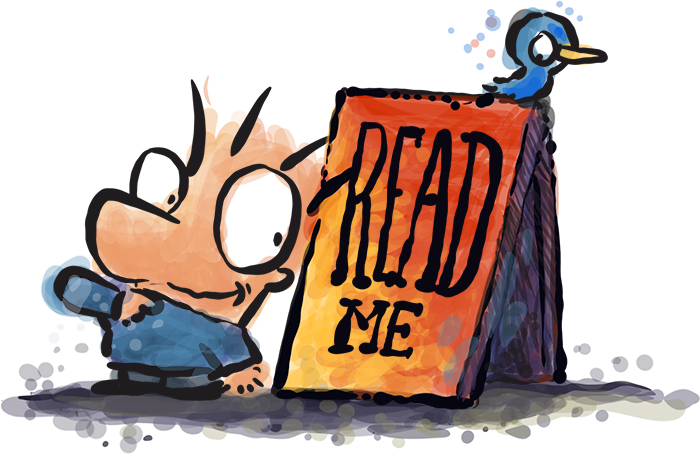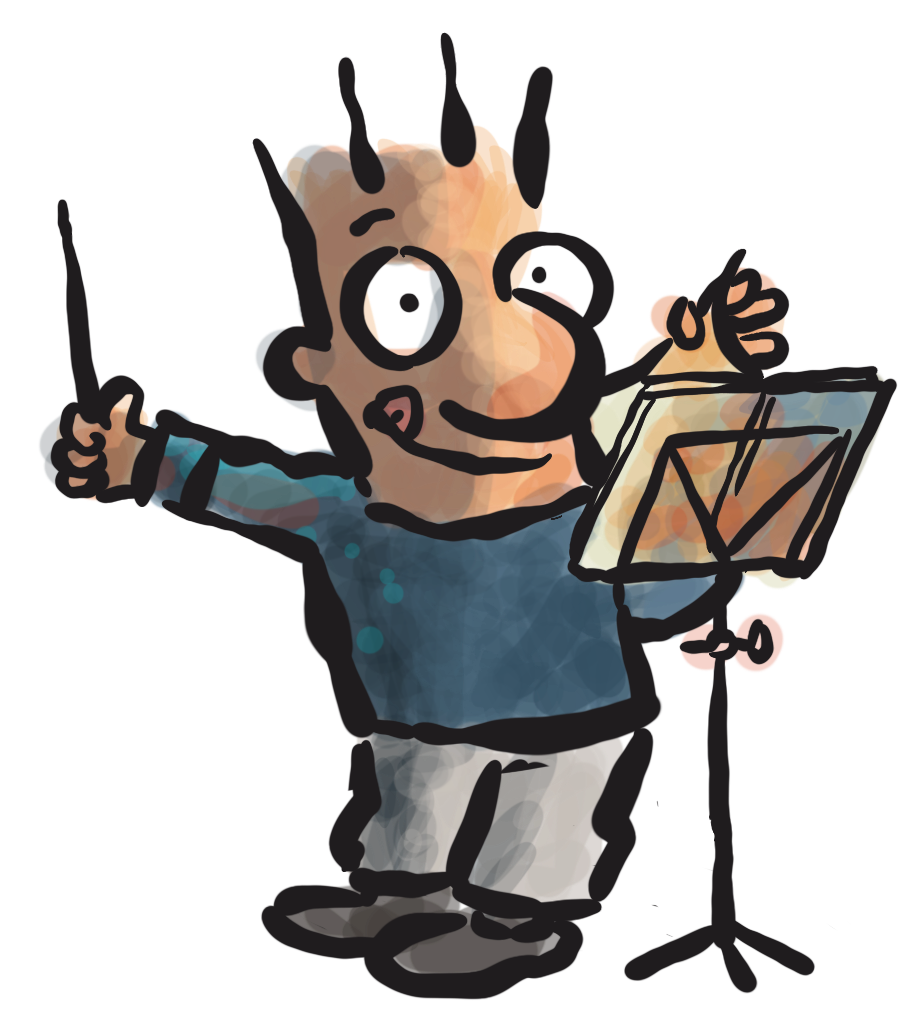
Cartooning Course: How To Develop Your Cartoon Character
Learn how to draw outstanding cartoons and create your own character (even if you can't draw a straight line)
Wouldn’t you like to draw cartoons to liven up your website, blog or presentations?
Wouldn’t it be great if you could draw your own cartoons instead of having to depend on someone else—or worse, buy some ill-fitting clip art?
And what if you can’t draw a straight line?
We all say it without thinking about it. When someone says: “Can you draw?”, we answer the question in an almost identical fashion. We all admit, we can’t draw a straight line.
Well that’s good news, because if there’s one place you don’t have to draw a straight line, it is in the practice of cartooning. You can draw wonky, shonky, monkey lines—if you have to draw lines at all. And in a few months (yes, just mere months) you’ll find yourself far more confident drawing. And strange as it may sound, people will come up to you and ask you: “Are you a cartoonist?”
So can you be a cartoonist?
Is it just an inborn talent? Or can anyone draw? The interesting fact is that anyone can draw and draw well. And you don’t have to believe me. You can go to any school on the planet and find a class where there are five-year olds.
Walk into that class and ask the class: “Who can draw?” And watch as every single hand goes up. Then if you have the chance, go back to that class after ten years, and ask the same question. And only a hand or two goes up.
So what’s happening? Did everyone lose their talent? No they didn’t. At five, every child knows how to draw and knows nothing about maths, history and science. At fifteen, every child knows maths, history and science—and has forgotten how to draw.
The Da Vinci Course brings back those memories
You can be five years old again and have a blast! And interestingly you’ll start drawing like a five-year old but soon progress to the state where people will indeed come up to you and ask: “Are you a cartoonist?”
What if you can't even draw stick figures?
Would Wiz Withers really become a cartoonist, considering he’d been struggling with stick figures? Clients who go through the cartooning course are stunned at the progress they make and go on to become accomplished cartoonists, much to their own surprise.
Note: The course has evolved over the years. Hence some of the elements that Wiz Withers talks about doesn't exist. In short, the course gets you to creating your own cartoon character without all the repetitiive nature of the earlier courses.
Introducing the Da Vinci "Create your Character" Course.

Creating your cartoon character is one of the most outstanding achievements for any illustrator. When you can make a character, you can use it just about anywhere. You may use it on your website, blog, presentations, books, etc. However, you may also use it for personal use, to draw cards, or to keep a visual diary.
If you've been through this website and seen the products on Psychotactics, you know how the cartoon character (Cuatro) has been used almost everywhere. This character creation is guaranteed even if you're an absolute beginner. How do we know this to be true? Everyone (without exception) creates their character on this course. It sounds bizarre, doesn't it? Here you are, barely able to draw squiggly lines and in a matter of months, you will not just have a character of your own to use as you like.
How the Da Vinci cartooning course is designed

Three core elements make this course effective:
- Element 1: A teacher who's a ‘student'
- Element 2: A system based on getting things ‘wrong.'
- Element 3: Creating your character in 12 weeks—Everyone does it, regardless of your skill level.
Element 1: A teacher who's a ‘student'
In 2010, I took a watercolour course. The class was held once a week, lasted three months (I think), and cost me about $400. And guess what? I learned a bit. The others on the course also learned a bit. But that was it. A bit was all we learned. And the reason we go about learning only little bits is that ‘once a week’ is not the best way for the brain to learn anything.
Besides, my watercolour teacher wasn't a student. He was a teacher. Or should I say ‘demonstrator'? He demonstrated how something should be done. And we followed. And that's not the kind of teacher you need. You need a teacher that's hungry to learn. That teacher is always playing ‘student'.
And when I say playing ‘student', it means they are always keen to learn how to teach you better. And in doing so, that teacher improves their teaching and skill. A teacher who's a demonstrator has no incentive to do anything other than just show you what you need to do. So first, you need that ‘hungry' teacher. But that's not enough. You also need a solid system in place.
Element 2: A system based on getting things ‘wrong.'
Almost every educational course follows a system. Yet, the system is primarily based on getting things right. This is a problem, of course. If you're only focused on getting things right, you go into freeze mode. You criticise yourself. You think your work is terrible. And guess what?
Your work worsens, and you can't draw (let alone learn any skill). However, a well-designed system takes the fear out of the student. This is mainly done by getting things ‘wrong'. And then fixing them. The fear goes away when your assignments are built around getting things wrong. And you, ironically, get things right. Once the brain freeze goes away, the playful brain comes to the forefront. And then, magic happens.
Element 3: Getting from Point A to B confidently and quickly
Anyone telling you you need 10,000 hours to be good at something is slightly misguided. You may need a lot of training to be at Olympic standard, but you can learn most other skills quickly. Imagine someone telling you you needed 10,000 hours to be good at driving a car. In this course, you will create your own character in 12 weeks.
In every batch and every course we've had, clients go from where they are to creating a character. And it's all done within 12 weeks.
It's also a ton of fun because you're drawing cool cartoons. Instead of some boring skill, you're learning something that makes you (and the people around you) feel good. Best of all, you can do this at your dinner table and don't have to shut out the rest of your friends and family.
What's involved in this course?

- You show up five days a week.
You are given the entire week's assignment in advance and need to show up every day, five days a week. Instead of rushing madly ahead, you learn a concept and then have all week (or sometimes two weeks) to get comfortable and confident. However, without the daily activity, you will need to make big leaps, and we don't want that, do we? Tiny increments make learning a lot more fun. - There is no need to show up on any live calls
This course doesn't require you to be on a live video call. Instead, the entire course is taught through a forum (yes, ha, ha, a forum). You'll see why that system is superior to all the bells and whistles on most other courses. You don't need to show up at a fixed time, either. Just so you know, you only need to ensure you do your assignment within that day. For example, let's say it's Monday in New Zealand, and you live in that country, so you'll have to post your assignment sometime on that particular day.
Have a look at the prospectus
The prospectus takes you on the journey of how the DaVinci Course came about, and then it moves into how the course will be conduct. Click here to read this tiny document.
Course details
1) When does it begin and what is the duration?
1a) Can I see the syllabus?
2) What materials will I need?
3) Who is conducting the course and how is the course conducted?
4) How much time will I need to practise every day?
5) Is there a money-back guarantee?
6) Are you pretttttttttty sure I don't need skills to do this course?
7) What does it cost? And do you have an installment plan?
8) How do I join? Where do I pay?
1) When does it begin, and what is the duration?
The 2028 batch will run for 12 weeks, from 8 September to 30 November 2028.
1a) What is the syllabus?
A syllabus should be like a river—changing as it goes. Even so, the river has some sort of direction. This PDF document shows you what's possible. You rapidly go from saying, “I can't draw” to being able to draw in the first week itself.
Click here to download the syllabus.
2) What materials will I need?: Ideally you'll need an iPad or some kind of digital tablet. While pen and paper is usually enough, the world is now truly digital and you can do a lot more with an iPad or tablet. However, there are people who get very good at drawing and complete the entire course using just pen and paper. It's a choice you can make, but if you have the option, get yourself a tablet, because you're going to need it sooner or later anyway.
3) Who is conducting the course and how is the course conducted? Click here to read the prospectus.
Sean D'Souza will conduct the course via our Psychotactics Training Forum. All your assignments will be given to you through a forum. Don't worry if you've never been on a forum before; we will take you through the process step-by-step in tiny increments.
4) How much time will I need to budget every day?
It depends. You should budget 30-45 minutes each day just for drawing. Some days you’ll be so engrossed you’ll draw for longer. But in just 30-45 minutes a day, you will achieve an enormous amount. It's important to note that you will also be in a forum with a tiny group of about 5-7 others. You will learn a lot from looking at their work (and in turn they will see your work). To make good progress, you simply need to do your own work. However, to become exceptionally good, you also need to spend some time (any time in the day) looking at the work of others within your group. Hence, the correct answer would be 30-45 minutes, plus some additional time just looking and engaging with others. This activity can be done at any time during the day.
5) Is there a money-back guarantee?
No, there is no money-back guarantee. We guarantee that you will get the skill–because that's what you signed up for in the first place. The goal is to make you a really good cartoonist and that's what you'll become.
6) Are you pretttttttttty sure I don't need skills to do this course?
Yes, you don't need any specific skills. You will achieve what is set out in the syllabus.
7) What does it cost? And do you have an installment plan?
Please scroll down for the details.
Note: There is also a 4 Monthly Installment Payments.
8) How do I join? Where do I pay?
You've to get on the waiting list. Here is the link – waiting list for 2028, click here.


Debra Rilea,
Massage Therapist
USA
“In this course you are never expected to run before you can crawl. The basic concepts build and build, until you have developed a skill. But once you've learned it, you will move forward too. You have to practice, practice, practice. This is a good thing. It's the only way to learn.
From a business prospective when I post a cartoon to my Facebook page, our views increase by the hundreds. People are clearly responding to the cartoons. Again, wow.”
I had two specific expectations.
• To have fun. Achieved! This course was fun. Oh sure frustrating, demanding and all that too but mostly fun.
• To learn how to draw cartoons that could be used for my business. Achieved! I now use cartoons on my Facebook page and will soon branch out to using them in our printed curriculum, website and more.
I loved that the course was actually for beginners.
No assumption about what we did or didn't know already. We all started from square one. That was refreshing. No one could critique my circles as “wrong”.
Then suddenly other students were getting gold stars and I wasn't! My competitive side was awakened. But my philosophy about competitive feelings is that they indicate a lack in me. So I re-read all the instructions, re-watched every video and read every post in the forum. Yep, it took some time.
What did I discover? Well, it wasn't a secret, I needed to focus on circly-circles and practice, practice, practice. Just like the instruction said. The assignments were not about doing my sketches “as good as someone else”, it truly was about letting go and making those circly-circles.
Once I figured that out the course became much, much easier.
It is difficult for me to remember the transition from Phase 1 to Phase 2.
But I do remember feeling very, very fortunate that we had the opportunity to continue. The learning definitely escalated with more challenging assignments. Once I started to feel completely comfortable with a character or technique, here would come another challenge. It was impossible to stagnate.
My fears
Being “good” enough. A silly fear but a powerful one. Part of overcoming it was that I personally was in a great space to be a student. So I kept reading and re-reading those instructions. And if all else failed I would tell myself, “Wax on, wax off, baby!”
How did I overcome them?
Making a commitment was the best method. Having a specific length of time for the assignment was super helpful in the beginning. Posting on Facebook where my friends became an additional group for accountability helped. I have a very supportive and occasionally pushy husband who assists me to complete tasks. And ultimately, I just did it because I fell in love with cartooning.
Even still with that commitment and love affair, it was really hard to take both the Cartooning Course and the Article Writing Course at the same time. Although my learning and practice times on the Cartooning Course were reduced I'm pleased I stayed with it.
You are never expected to run before you can crawl
The basic concepts build and build until you have developed a skill. But once you've learned it, you move forward too. You have to practice, practice, practice. This is a good thing. It is the only way to learn. If you are not good at drawing—no problem. You'll learn everything you need to right here. It all starts with a circle and not even a perfect circle, just a circle.
My recommendation for anyone who wants to do this course
Anyone who wants to draw cartoons regardless of current skill level.
Why? Because it is a system/method that works.
I admit that I'm continually surprised how people I rarely see have shared:
“Your cartoons are the only reason I even visit Facebook anymore. I love them.”
“I love your cartoons. They make me happy. I look at them every day.”
Both of these statements were made to me when I saw acquaintances that I hadn't seen for a long, long time and figured they never, ever even looked at my Facebook posts. Wow, to know that my little cartoons had a positive emotional impact on others, I was literally overcome both times. It was an unexpected bonus to bring others happiness with cartooning.
From a business prospective when I post a cartoon to my Facebook page our views increase by the hundreds. People are clearly responding to the cartoons. Again, wow.
Personally I loved the structure of this course along with the relaxed attitude
Have a look at the syllabus
A syllabus should be like a river—changing as it goes. Even so, the river has some sort of direction. This PDF document shows you what's possible. You rapidly go from saying, “I can't draw”, to being able to draw in the first week itself. Click here to download the syllabus.

Wiz Withers,
Ad Words Consultant,
Washington D.C. USA
“The problem in many of today's websites and written materials (white papers, case studies, etc.) is the over-reliance on stock photos. Proper graphics add so much, but it's so easy to get them wrong.
And so many of the graphics used are overdone. I want something unique, without having to hire a cartoonist every time I want something. So many times I've thought: “all I need now is a cartoon that shows ___.”
I wanted the ability to draw that cartoon. When I was at a recent workshop, a number of folks asked me how many years I had been drawing. When I answered “about 7 months”, they looked as though they thought I was kidding.”
1) What were your expectations when you joined the course? What did you hope to achieve?
My primary reason for participating in this course is to be able to illustrate my written work. When I read “The Brain Audit” I was just as fascinated with the cartoons as I was with the written material. What a terrific way to dress up a manuscript – unique, yet adds to the message. I really want to be able to do that for my own writing, and also for my business partner's work as well – something unique, that no one else can copy.
What I REALLY wanted to achieve was the development of a “signature” character – like Cuatro is to Sean D'Souza. When anyone in Sean's audience sees Cuatro – they know it's Sean. I was looking to develop my own character.
The problem in many of today's websites and written materials (white papers, case studies, etc.) is the over-reliance on stock photos. Proper graphics add so much, but it's so easy to get them wrong. And so many of the graphics used are overdone. I want something unique, without having to hire a cartoonist every time I want something. So many times I've thought: “all I need now is a cartoon that shows ___.” I wanted the ability to draw that cartoon – nothing fancy, but not something like a toddler would draw.
2) Can you describe the journey through the first part of the course? (First three months—Starter Phase 1)
The first part is essentially the fundamentals – learning the building blocks of sketching. We found out quickly that as adults, we learn just like kids do: by copying. Many of our early assignments consisted of copying well-known (and not so well known) cartoon characters. Some of them were fun to draw, but there was one that was a real chore for me. Nevertheless, I kept at it.
After several weeks of copying, we had an exercise that seemed to make no sense – “making mistakes”. The exercises focused on speed at the expense of accuracy. Initially these were a challenge for me, since I kept wanting to slow down and get the details right. But I was amazed that, after a week of “speed work”, my speed drawings were almost as good as my “slow” drawings. That was a big “aha” moment for me.
In addition to learning the fundamentals, we were also learning habits – the idea of sketching every day (or almost every day). Sketching became part of the daily routine. I had to experiment a bit to find the best time of day, but I found a routine that worked.
After the initial three-month period, we started learning more advanced concepts: composition, line quality, daily diaries to name a few. At this point, the course went through a noticeable change. We weren't just putting together simple drawings anymore – we (or at least I) had to spend some time thinking about what the drawing was going to be “about”. I was no longer just sitting in a chair, sketching out the first thing that popped into my head. Now my cartoons were starting to communicate ideas. Cartooning was still fun – but there was a higher level of “work” involved now. We were taking the next step toward becoming professional cartoonists. It was exciting, but a little overwhelming at times.
3) What were your fears as you tackled the assignments? How did you overcome them?
Going in, I didn't think I had any “fears” per se. I admit that, at the very beginning, I was concerned about letting other people see my attempts at drawing. That quickly evaporated when I realized that many of us were in the same boat. Besides, it's hard to mess up circles! So we had fun.
As the course got more involved, though, I began to get concerned at the time commitment. I was sketching, inking, scanning, importing – all of which took time. It was not uncommon (for me) to spend a total of 2-2.5 hours on a single assignment. It wasn't a high-pressure situation, but I was starting to wonder if I would keep up the pace. I was constantly reminding myself that I was taking this course for a purpose. Also, when I saw the quality of work my fellow classmates were posting, I was determined to keep up. They inspired me to keep going – and a couple of them told me that I inspired them. So: focusing on the end result, plus accountability to the group – that's what kept me going through the busy times.
Probably the closest thing to a “fear” was when we were encouraged us to start sketching in public places. Heretofore, the only people that had ever seen my sketches were my wife, Sean, and my classmates. I didn't rush right out to begin public sketching (I work out of my home, and I live in a rural area, so I'm rarely at a coffee shop or a café). I did start posting some of my work on my Facebook page, and also sketched a bit at some workshops that I attended. Today, I really don't care who watches me as I sketch – not because of the quality of my sketches, but because my confidence level as a cartoonist is much higher. I still consider myself a relative beginner, and I have a lot to learn – but I no longer am concerned if someone sees my “less than perfect” work.
4) Can you talk about the method you used to make sure you got your work done?
For me, it was always about two things: 1) making cartooning a priority, not an after-thought; and 2) establishing a routine. Initially I began cartooning in the evening after dinner. In the early weeks of the course, when the assignments were simple, this was easy to do. However, as things got a bit more demanding, I knew I needed more emotional energy – so I switched to drawing early in the morning, before my workday began.
That routine has been the most successful for me. I sketch, post, and comment in the morning – then I'm done with my assignments for the day. I still may sketch for fun later, but I made sure that my homework was completed and posted before I began work (as much as possible).
As I said earlier – one of the biggest reasons I made sure I completed my daily assignments was the group accountability. Everyone had the same time issues – yet we all managed to post our daily assignments. Knowing the group expected to see my work was a big motivator to keep going.
5) Can you talk about the experience with your group?
This was my second Psychotactics course, so I was already aware of the importance of the group. And they didn't disappoint: they were encouraging, inspiring, and occasionally critical when they needed to be. Originally, we were divided up into smaller sub-groups – but as folks started fading away, we were left with a core group of about 12 people. For the second part of the course, this core group stayed fairly intact.
For me, the group serves as motivation to get my work posted. I know they'll be checking on me, so I want to make sure I've done what I committed myself to do. Additionally, our group includes several folks who have some experience as artists and designers. They're a great source of tips and tricks to make learning faster and more fun. They're also a great source of ideas to try. And they're great people to be around, too! (At first, the experienced artists intimidated me a little – but they were some of the most encouraging members of the group.)
6) Can you describe how the course is conducted
It's not a Western education teacher/student philosophy. It's more of the Eastern master/apprentice – relationship. On the very first day he posted the familiar “wax on – wax off” videos from the “Karate Kid” movie – it was our assignment to watch them.
I will caution you – it's one thing to watch “wax on, wax off” and understand it intellectually. It's quite another to experience it and accept it internally the first time (or at least it was for me! ) Over time several members left the course – in part because of the reluctance to accept this philosophy. Once you do accept it, though, the magic happens!
“Process” and “effort” are far more important than “results”. This often takes time for students of Western education systems to comprehend and accept – I know it did for me!
7) What would you say to someone who says they're not good at drawing?
That's exactly what I did say in the beginning. I really didn't think I could draw at all. I couldn't even play the game “Hangman”, because I couldn't draw the stick figures!
But the question then becomes – do you want to learn?
Specifically, do you want to learn to draw cartoons? And for me, the answer was a resounding “yes”. If you're willing to trust the process, and willing to put in the daily practice, you'll be amazed at how quickly you'll be drawing. But you have to put in the work.
8) Who would you recommend the course to, and why?
Literally: anyone – adult or child – that wants to draw better cartoons. Kids take to this like a duck to water – I was amazed at some of the work that the kids in our initial group were doing. However, as I said earlier – if you really want to get good at this, you have to put in the daily practice. It's not hard, and for the most part, it's not super-time-consuming. Because of that, though, it's easy to say, “Oh, I'll get to that later.” And if you get in the habit of putting it off, the group continues without you, and it's just that much harder to get restarted.
So if you want to really want to learn to draw cartoons, the course has to have some level of priority. It's all up to you.
9) Can you tell us of how friends, family, kids, strangers have reacted to your cartoons?
I'm amazed at the feedback I get from family and friends who have seen my sketchbook, and especially the feedback on my Facebook page. Everyone say the same thing: “I never knew you were an artist!” (Before the course, I never knew I was one, either!) One person published one of my cartoons on her blog (with my permission) – she offered to pay me, but I was so surprised I just gave her permission (I won't do THAT again! )
When I was at the DC Uniqueness Workshop, a number of folks asked me how many years I had been drawing. When I answered “about 7 months”, they looked as though they thought I was kidding.
However, the most special moments for me are these: Every year my wife and I give each other cards at the usual times. And each time the cards get placed on the mantle for a week or so, and then get thrown away. Since I've started cartooning, I've given my wife a cartoon for our wedding anniversary, for Valentines Day, and a couple of other occasions. Unlike normal cards, she hasn't thrown the cartoons away, but rather has placed them on her desk and other locations in her office. She's not a “collector”, and hates clutter. So the fact that she has kept these means a lot – and tells me the value they have for her.
10) What else would you like to add?
1) Pick up a copy of “The Talent Code” and study it. Just do it. Get it and read it. At the start of this course, I picked up the book and read it. I wish I had done so two years ago! The teaching philosophy is based on this book – so if you really want to understand the “why”, this is where you'll find those answers.
2) Do the exercises daily. Don't sit down once/week and do a whole bunch of work at once – better to do a little bit every day. It may help to schedule time in your calendar. But if that's not your “thing”, just keep a pencil & paper handy wherever you go. You don't need to go to an art store and buy fancy pencils, pastels, sketchbooks – just keep a notebook and pencil nearby, and when you have a few moments to yourself, sketch. Sketching daily will be a lot easier to accomplish, and will make it feel much less like work.
3) Don't be intimidated by technology – specifically, posting drawings online. Picasa, Facebook, your own site – there is no “right” answer. Just pick a method that works for you and learn it. We had several folks in our class that, at the start, had no experience with this sort of thing – now they're Facebook/Picasa experts. If you have a question about technology, don't wait – ASK! Someone – will walk you through the process.
4) Don't be intimidated by the other students. You're all coming into this course with various backgrounds and different levels of experience in sketching. Some of your fellow students may look like accomplished artists. Some barely can draw a stick figure (me). Doesn't matter – everyone will be doing the same exercises. Remember – it's not the results so much, but the process. The “experienced” artists will be just as excited for you as you are – so don't let that worry you.
5) Perfectionism is just an excuse to NOT do something, and it takes all the fun out of it. We all want our work to be perfect. We'd love to have others say – “Wow! You must be a professional (X)!” And so when the results of our efforts fall short of where we want them (or where we think they should be), it's easy to blame ourselves. “I don't want anyone to see this until it's perfect!” And that attitude will stop you in your tracks every time. Some of the exercises are designed for the expressed purpose of making mistakes. That's hard to get used to at first. But once you release the “it's gotta be perfect” mentality, you'll get a lot more accomplished, and you'll have a lot more fun.
6) Speaking of which, remind yourself to have fun. We're not writing a business plan, we're drawing cartoons! Sometimes we allow our days to be so full that this becomes another chore. This isn't work – it's an “escape” from work. You will occasionally remind us to “Be 5” – as in, draw like a 5-year-old. Sketch because you love to do it, and don't get hung up on what the sketches look like.
Batch 2028 |
||
|---|---|---|
| Starts Sept 2028 | Regular | Premium |
| Part 1 To get the core elements of cartooning embedded in your system (4 weeks) |
||
| Phase 2 To get greater complexity that makes cartoons stand out from the run of the mill illustrations. (8 weeks) |
||
| Special Price | ||
| Option 1: Single Payment (Save over $100) | US$2775 | US$2875 |
| Option 2: 4 Monthly Installment Payments | $719 x 4 | $743 x 4 |










